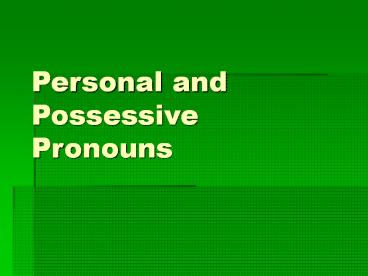Personal and Possessive Pronouns - PowerPoint PPT Presentation
Title:
Personal and Possessive Pronouns
Description:
Demonstrative pronouns are: This -- That These -- Those Indefinite Pronouns An indefinite pronoun does not refer to a specific person, place or thing. – PowerPoint PPT presentation
Number of Views:696
Avg rating:3.0/5.0
Title: Personal and Possessive Pronouns
1
Personal and Possessive Pronouns
2
What is a pronoun?
- A pronoun is a word used in place of a noun or
another pronoun. - The word that a pronoun stands for it called its
antecedent.
3
Its all about Mrs. Gay
- Spend 3 minutes telling your partner all about
your favorite teacher. (It doesnt have to be
me!) - There is only ONE RULE you must call that
teacher by their name you cannot use ANY
pronouns to replace their name. - Pronouns are words that replace nouns (I, me, we,
us, you, your, yours, he, him, she, her, it,
they, them)
4
Stop and Think
- How difficult is it to avoid using pronouns?
- What did the conversation sound like?
- Why are pronouns important?
5
What is a pronoun?
- A pronoun is a word used in place of a noun or
another pronoun. - The word that a pronoun stands for it called its
antecedent.
6
Pronouns and Antecedents
- Ray said he wanted musical talents to audition
for the play. - Chiyo and I auditioned together. We both got lead
parts.
7
Personal Pronouns
SINGULAR PLURAL
First person I, me (my, mine) We, us (our, ours)
Second Person You(your, yours) You (your, yours)
Third Person He, him, she, her, it (his, her, hers, its) They, them (their, theirs
8
Possessive Pronouns
- Possessive pronouns show ownership or
relationship. - Practice Apply page 10
- Write each pronoun and tell whether it is
personal or possessive.
9
Essential Question
- Why does using the correct pronoun matter in
writing? - Pronouns replace unnecessary OR repetitive nouns.
10
Reflexive Pronouns
- A reflexive pronoun reflects action back upon the
subject and adds information to the sentence. - Delilah prepared herself for a long day.
- A reflexive pronoun MUST have an antecedent!!
11
Intensive Pronouns
- An intensive pronoun adds emphasis to a noun or
pronoun in the same sentence. - The wait itself would take hours.
12
Reflexive and Intensive Pronouns
- Reflexive and intensive pronouns are formed by
adding self or selves to forms of the personal
pronouns.
Singular Plural
First person Myself Ourselves
Second person Yourself Yourselves
Third person Himself, herself, itself themselves
13
Demonstrative Pronouns
- Demonstrative pronouns point out specific
persons, places, things, or ideas. - Demonstrative pronouns help us indicate whether
things we point out are relatively near in
time/space or farther away. - Demonstrative pronouns are
- This -- That
- These -- Those
14
Indefinite Pronouns
- An indefinite pronoun does not refer to a
specific person, place or thing. - An indefinite pronoun usually does not have an
antecedent.
15
Indefinite Pronouns
Singular Another, anybody, anything, each, either, everybody, everyone, everything, much, neither, nobody, no one, nothing, one, somebody, someone, something
Plural Both, few, many, several
Singular or plural All, any, more, most, none, some
16
Interrogative and Relative Pronouns
- An interrogative pronoun is used to ask a
question. - A relative pronoun is used to introduce
subordinate clauses.
17
Interrogative and Relative Pronouns
Interrogative Who, whom, whose, which, what
Relative Who, whom, whose, which, that
18
In Class Practice DUE TODAY
- Complete Exercises A and B on page 13 of the
Language Network textbook. - Answer the Essential Question on the same page as
your Exercises A and B. - EQ Name 3 ways that pronouns can be used in
writing. (Hint Review the definitions of each
pronoun.)
19
In Class Practice DUE TODAY
- Language Network page 13
- Exercise A Write each pronoun identify its
antecedent if it has one. Label each pronoun as
reflexive, intensive, indefinite, interrogative,
or relative. - Exercise B Follow directions in textbook.
- Answer the Essential Question on your paper.
- EQ Name 3 ways that pronouns can be used in
writing. (Hint Review the definitions of each
pronoun.)































